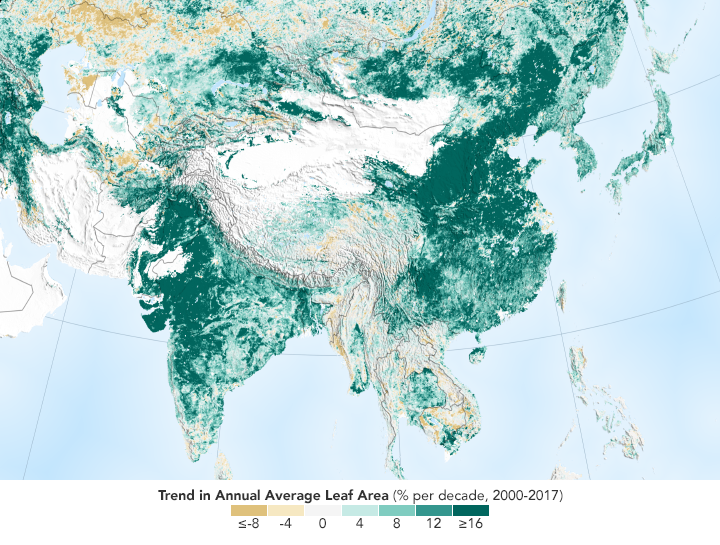China and India lead the world in making the planet greener
- By Rachana Gupta
 0 Comment(s)
0 Comment(s) Print
Print E-mail China.org.cn, March 2, 2019
E-mail China.org.cn, March 2, 2019

At the start of this century, it would have seemed inconceivable for the global hegemonic powers to imagine that the two most populous nations would be leading the world towards a greener future. However, that's exactly what is happening.
Just a decade ago, China and India were being lambasted by the international community for allegedly sabotaging the aims of the Copenhagen Climate Change Summit. However, the two countries have not only been able to turn things around but are now setting an example for the rest of the world.
A recent NASA report highlights how, despite being late-entrants to the list of environmental protection enthusiasts, they have been contributing immensely to making the planet greener over the past two decades.
The report, published in the journal Nature Sustainability on Feb. 11, says the Earth's green leaf area has grown 5 percent since 2000 and currently accounts for over 5 million square kilometers (an area comparable to the size of the Amazon rain forests).
According to Chi Chen, the study's lead author, a graduate researcher at Boston University's Department of Earth and Environment, "Although the nations encompass only 9 percent of the planet's land area enveloped in vegetation, they account for almost a third of the greening – a result which is absolutely in contrast with the widespread conception of land degradation in densely populated countries due to over-exploitation."
The study's lead researcher, Ranga Myneni, in a separate statement, mentioned that he along with his colleagues had identified the greening phenomenon in the mid-1990s with the help of high-resolution data captured from space by two satellites, Terra and the Aqua.
However, to eliminate the uncertainty of the role of human activities over the results, they further tracked the changes occurring in the total land area covered by vegetation over a long period.
In a further blow to the skeptics, the study revealed that China, despite possessing just 6.6 percent of the world's vegetated area, contributed almost 25 percent of the increase in the green leaf area. Out of this, 42 percent is from afforestation and 32 percent from farming activities, thanks to its aggressive tree-planting and forest conservation and expansion programs.

Last year, the Chinese State Forestry Administration pledged to cover almost 23 percent of the mainland's total land area with forests. Additionally, several forestation projects in the northern parts of Hebei, Inner Mongolia and Qinghai, covering 6.6 million hectares (almost the size of Ireland), are underway.
Moreover, China, in line with its commitment to the Paris agreement to cut its greenhouse gas emissions per unit of GDP by 60-65 percent from the 2005 levels, has made significant progress in employment of clean energy. In 2018, it generated a total of 1.87 trillion kWh of clean energy, up 170 billion kWh from 2017.
Notably, in 2015, it surpassed the U.S. to become the largest market for electric cars with over 200,000 registrations. At the same time, solar power cell production in China saw a 100-fold increase between 2005 and 2014, enabling it to lead the world in renewable energy sources.
India, meanwhile, has contributed almost 6.8 percent to the growth of the green leaf area, out of which 82 percent of the total contribution is made by its croplands as a result of intensive agricultural activities. Despite lagging behind in terms of resources, the country has demonstrated a vigorous resolve in restricting its employment of fossil fuels.
It curtailed its carbon emissions by 13.5 percent between 2005 and 2012. Along with the commitment to enhance its agricultural capacity, India aims to shrink its consumption of fossil fuels by a further 40 percent and gradually shift towards sources of renewable energy. Its ambition is to produce 175GW from solar power by 2022.
But on the other hand the U.S., the world's largest economy, has backed down from its commitments made under the Paris agreement, arguing, in 2017, that they would strangle the American economy and lead to major job losses.
This is in sharp contrast with the attitude of China and India who, at a crucial point in the fight against climate change, and despite being the world's most populous nations, are acting as leaders and setting an example for the rest of the world.
Although there is still a long way to go in the fight against global warming, the encouraging results of studies such as this one by NASA can act as a positive incentive for everyone.
Rachana Gupta is an active blogger, poet and freenlance content writer.
Opinion articles reflect the views of their authors only, not necessarily those of China.org.cn.
If you would like to contribute and have specific expertise, please contact us at opinion@china.org.cn.





